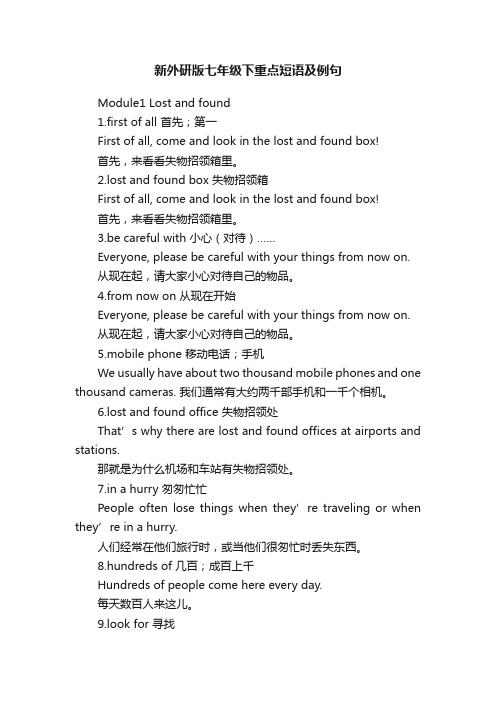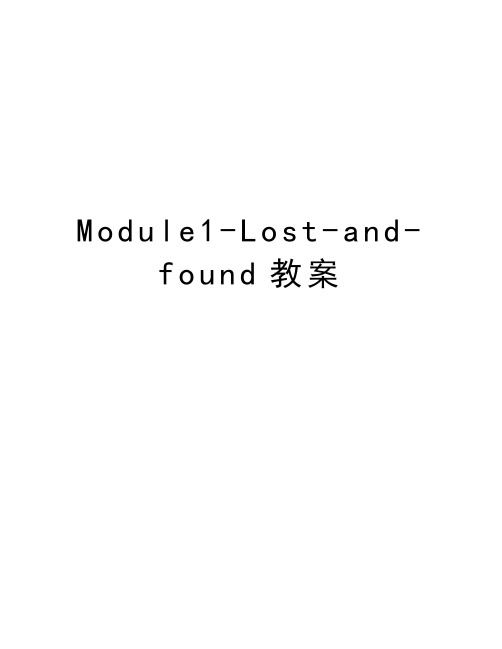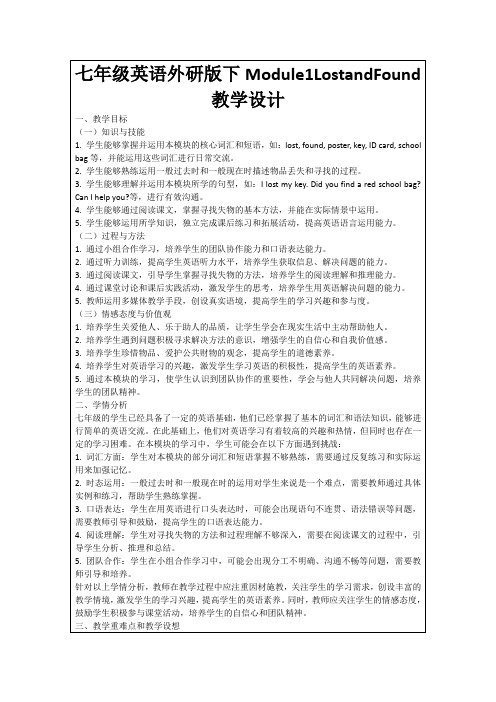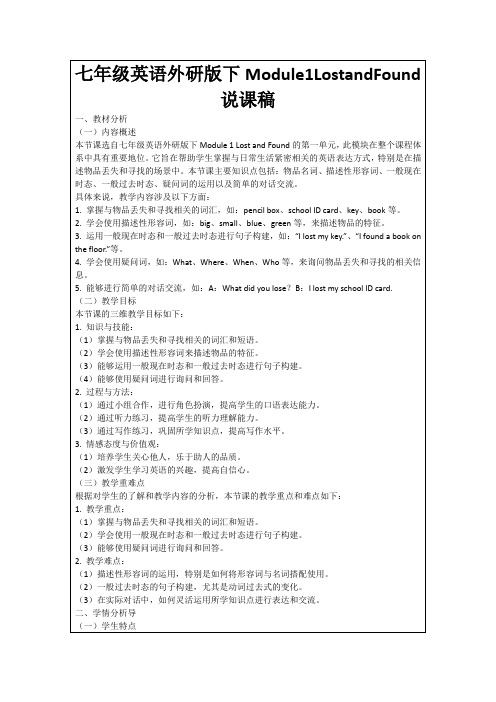Module 1 Lost and found
巴林右旗第三中学七年级英语下册 Module 1 Lost and found知识梳理外研版

Module 11。
lost and found box 失物招领箱2。
welcome back 欢送回来3.first of all 首先4。
here is/are。
.。
这有。
. 5。
from now on 从现在开始6。
be careful with 小心保管7。
whose bag 谁的包8. talk to sb。
与某人交谈9。
mobile phone 移动,10. get on 上车( get off 下车〕11。
two thousand 两千〔thousands of 数以千计的。
.) 12。
look for 寻找13。
at the moment 现在14。
in a hurry 匆忙地15。
a lot of 许多,大量16。
hundreds of 数以百计的17。
on the train 在火车上18。
every day 每天19。
such as 例如20。
make a list of 列一张。
的清单21。
ask/answer questions 问/答复下列问题重点句子:1。
Welcome back to school!欢送回到学校。
2。
Whose bag is this?这是谁的书包?3。
It’s mine.它是我的。
4.Are these crayons yours?这些是你的蜡笔吗?5。
Whose tapes are these?这些是谁的磁带?6. Here's a purple wallet!这儿有个紫色钱包。
7。
I think it’s Betty’s.我认为它是贝蒂的.8。
Everyone, please be careful with your things from now on.请大家从今以后仔细对待你们的东西。
9. People often lose things when they're travelling or when they're in a hurry。
Module_1_Lost_and_found

Module 1 Lost and found Unit 1一、重点词汇拓展1. 钱包________2. 橡皮擦 ________3. 谁的________4. 发现;找到_______5. 失物招领箱_____ _____ ______ ______6. 我的(东西) ________7. 你(们)的(东西)________8. 她的(东西)________9. 从现在开始_______ _______ _______10.移动电话________ ________二、根据汉语意思,完成句子1. 欢迎回到学校。
________ back ________ school.2. 这些蜡笔是你的吗。
Are ________ crayons ________?3. 这是谁的手表?________ watch is this?我认为是它是Tom的。
I ________ it’s ________.4. 请小心看好自己的物品。
Please ________ ________ ________your things.5. 让我看一看你的护照。
______ ______ ______ your passport.6. 从今以后我们必须好好学习。
We must study hard _____ ______ ______7. 这有一些很好的手套。
_______ _______ some nice gloves.重点难点,一网打尽。
三、根据句意及首字母提示写单词1. Dad givess me a new baseball g________2. I lose my w________ so I don’t have any money now.3. Be c________! The car is coming.4. Tony takes some photos with a new c______5. —Thank you! —You are. w________6. —W_____ do you like apples?—Because they are delicious.7.Tom goes to school in a h______.四、用所给单词的正确形式填空1. Your ruler is longer than________(my)2. —What are they doing?—They ________(play) basketball.3. There are many things in the________(lose) and________(find) box.4. —________(who) bag is this?—It’s ________(she).5. Lingling likes_______(do) housework.Unit 2一、重点词汇拓展1. 机场;航空港 ____________2. 百 ________3. 千 ________4. 几百;成百上千________ _______5. 飞机________6. 奇怪的_______7. 寻找_________ 8. 香肠_________二、根据提示完成变化三、用所给词的正确形式填空1. Mike often ________(play) football.2. ________ you ________(like) Chinese food or Western food?3. My English________(teach) is an old American.4. —I feel very bored.—What about ________(see) a film at the cinema?5. Jerry ________(not do) his homework at noon6. There ________(be) a pen and two boos on the desk.重点难点,一网打尽。
Module1 Lost and found重点精讲与练习

Module1 Lost and found重难点精讲1.主题功能:能够谈论物品和物品的主人。
2.重点单词:camera, crayon, airport, phone, leave等。
3.重点词组:first of all, lost and found box, from now on,in the hurry 等。
4.重点句型:Whose bag is this? Oh sorry! It’ s mine.Are these crayons yours?Here’s a purple wallet.核心语法:名词性物主代词重难点Firs t of all, come and look in the lost and found box.首先, 过来看看失物招领箱吧。
first of all 意思是“首先”, 和at the beginning意思相同。
题一:翻译:首先,我想介绍一下我自己。
翻译:在失物招领箱里面有一些东西。
首先,你应该向他道歉。
_________ ________ _________, you should say sorry to him.Whose bag is this? Oh sorry! It’s mine.问句是whose引导的特殊疑问句,whose意为“谁的”。
题二:翻译:这是谁的钱包?它是杰克的。
翻译:这是我的全家福照片。
这些是动物的照片。
Here _____ some ways to learn English.A. haveB. hasC. areD. isEveryone, please be careful with your things from now on.be careful with意思是“小心(对待)......”。
小心那把刀,否则你会划伤你自己。
Be careful with that knife, or you’ll cut yourself. CARE的派生词:careful,carefully,careless,carelessly.from now on意思是“从现在开始”。
外研版初中英语初一下册Module 1 Lost and found 知识讲解

+ Module 1 Lost and found精讲精练词汇精讲1. welcomewelcome 是动词,意为“欢迎”,后面可以直接跟表示人的名词。
例如:Let ’s welcome the visitor . 让我们欢迎来宾。
【拓展】1) welcome sb. to sp. 欢迎某人到某地 例如:W elcome our friends to Beijing. 欢迎我们的朋友到北京来。
2) Y ou are welcome.意为“不用谢。
” 例如:— Thank you for your help. 谢谢你的帮助。
— Y ou ’re welcome. 不用谢。
2. minemine 是名词性物主代词,相当于 my + 名词。
例如:The coat is mine. 这件上衣是我的。
【拓展】(1) 名词性物主代词常用来避免和前面已提及的名词重复,相当于(形容词性物主代词 名 词)。
其分类形式如下:形式 人称单数 第一人称 第二人称第三人称复数 第一人称第二人称 第三人称 名词性物主代词 mine yours his hers its oursyours theirs(2) 名词性物主代词的用法:I. 名词性物主代词可用作主语、宾语和表语,可单独使用,其后不再跟名词。
1) 用作主语。
例如:That isn ’t my car . Mine is at home. 那不是我的汽车。
我的汽车在家里。
2) 用作宾语。
例如:I have brok en my pen. May I use yours? 我折断了我的钢笔。
我可以用一下你的吗? (作动词的宾语)He wasn ’t in my room. He might be in his. 他不在我的房间。
他可能在自己的房间。
(作介词的宾语)II. 名词性物主代词可与介词 of 构成短语,用作后置定语,表示从属关系。
例如:Jack is a friend of mine. Jack 是我的一个朋友。
Module1LostandFound教案

二、核心素养目标
《Module1 Lost and Found》教学旨在提升学生以下英语学科核心素养:
1.语言能力:通过学习本模块,学生能熟练运用一般现在时描述失物招领情境,掌握相关词汇和日常交际用语,提高英语表达水平;
2.一般现在时的运用:描述失物招领情况,如:“I lost my book.”、“I found a key.”;
3.日常交际用语:如何询问和回答失物招领相关事宜,如:“What did you lose?”、“I found your phone at the school gate.”;
4.失物招领启事的书写格式和要点。
(3)失物招领启事的书写格式和要点:学生可能对如何书写失物招领启事感到困惑,包括如何组织语言、表达清晰等。
举例:
-教师可以通过对比词汇的用法,帮助学生区分“lose”和“find”等易混淆词汇。
-设计互动游戏,让学生在游戏中练习一般现在时的动词变化,降低学习难度。
-提供失物招领启事的模板,指导学生按照一定格式书写,逐步掌握书写要点。
4.课后布置相关作业,让学生在实践中进一步巩固所学知识。
在教学过程中,教师应针对重点和难点内容,采用多种教学方法,如情景教学、分组讨论、互动游戏等,帮助学生充分理解和掌握本节课的核心知识。同时,关注学生的个体差异,给予有针对性的指导,确保学生能够突破难点,提高英语综合运用能力。
四、教学流程
(一)导入新课(用时5分钟)
同学们,今天我们将要学习的是《Module1 Lost and Found》这一章节。在开始之前,我想先问大家一个问题:“你们在日常生活中是否遇到过丢失物品的情况?”比如,丢失了钱包、课本或者钥匙等。这个问题与我们将要学习的内容密切相关。通过这个问题,我希望能够引起大家的兴趣和好奇心,让我们一同探索失物招领的奥秘。
初一英语外研社版 Module 1 Lost and found 知识讲解

Module 1 Lost and found精讲精练词汇精讲1. welcomewelcome是动词,意为“欢迎”,后面可以直接跟表示人的名词。
例如:Let’s welcome the visitor. 让我们欢迎来宾。
【拓展】1) welcome sb. to sp. 欢迎某人到某地例如:Welcome our friends to Beijing. 欢迎我们的朋友到北京来。
2) You are welcome.意为“不用谢。
”例如:—Thank you for your help. 谢谢你的帮助。
—You’re welcome. 不用谢。
2. minemine是名词性物主代词,相当于my + 名词。
例如:The coat is mine. 这件上衣是我的。
【拓展】(1) 名词性物主代词常用来避免和前面已提及的名词重复,相当于(形容词性物主代词+名词)。
其分类形式如下:I. 名词性物主代词可用作主语、宾语和表语,可单独使用,其后不再跟名词。
1) 用作主语。
例如:That isn’t my car. Mine is at home. 那不是我的汽车。
我的汽车在家里。
2) 用作宾语。
例如:I have broken my pen. May I use yours? 我折断了我的钢笔。
我可以用一下你的吗?(作动词的宾语)He wasn’t in my room. He might be in his. 他不在我的房间。
他可能在自己的房间。
(作介词的宾语)II. 名词性物主代词可与介词of构成短语,用作后置定语,表示从属关系。
例如:Jack is a friend of mine. Jack是我的一个朋友。
(用于双重所有格)【注意】1) 在使用名词性物主代词时,必须有特定的语言环境,也就是要省略的名词大家已经知道,已经提起过。
例如:There is a book. It’s hers. 那里有本书。
七年级英语Module1 Lost and found

Module1 Lost and found【短语归纳】1. lost and found box 失物招领箱2. be careful with…小心…3. from now on 从现在开始4. (be) in a hurry 匆忙5. hundreds of 成百上千6. look for 寻找(过程)7. first of all 首先8. find 找到(结果)9. try to do sth 努力做某事(会成功)10. choose from 从…中挑选11. try doing sth 试图做某事(成功与否未知)12. at the moment 此时此刻13. such as 例如(用于列举)14. for example 例如【重点句型结构】1. Whose + 名词+is this ? 这是谁的…?2. help sb do sth. 帮助某人做某事3. Please be careful with…请小心保管…4. Welcome to + 地点欢迎来到…5. call sb at + 电话号码拨…给某人打电话【语法专项】物主代词:表示所属关系的代词(…属于谁的)人称单数复数形容词性物主代词名词性物主代词形容性物主代词名词性物主代词第一人称mymineourours第二人称youryoursyouryours第三人称hishistheirTheirsherhersitsits形容词性物主代词:必须和名词在一起,例如my father, your teacher...名词性物主代词:相当于与之相对应的形容词性物主代词+名词,例如This shirt is mine. =This is my shirt.Module2 What can you do?【短语归纳】1. get on well with sb. 与某人相处融洽2. play the piano 弹钢琴3. play table tennis 打乒乓球4. what about…?=how about…? ...怎么样?5. worry about…担心…6. be good at doing sth. 擅长做某事7. fly a kite 放风筝8. that’s all 仅此而已9. be ready to do sth. 乐于做某事【重点句型结构】1.What/How about doing sth? 做…怎么样?2.Would like to do sth. 愿意做某事3.promise to do sth. 承诺做某事4.play +球类名词玩…球5.play the +乐器演奏…乐器6.do (some) + 动词ing形式做…7.be sure of sth. 确信…(说话人的信念)8.be sure to do sth. 一定…(说话人的推测)【语法专项】情态动词can 的用法1.含义:表达人或物的能力,能或会.2.特点:情态动词can没有人称和数的变化,之后要加动词原形。
新外研版七年级下重点短语及例句

新外研版七年级下重点短语及例句Module1 Lost and found1.first of all 首先;第一First of all, come and look in the lost and found box!首先,来看看失物招领箱里。
2.lost and found box 失物招领箱First of all, come and look in the lost and found box!首先,来看看失物招领箱里。
3.be careful with 小心(对待)……Everyone, please be careful with your things from now on.从现在起,请大家小心对待自己的物品。
4.from now on 从现在开始Everyone, please be careful with your things from now on.从现在起,请大家小心对待自己的物品。
5.mobile phone 移动电话;手机We usually have about two thousand mobile phones and one thousand cameras. 我们通常有大约两千部手机和一千个相机。
6.lost and found office 失物招领处That’s why there are lost and found offices at airports and stations.那就是为什么机场和车站有失物招领处。
7.in a hurry 匆匆忙忙People often lose things when they’re traveling or when they’re in a hurry.人们经常在他们旅行时,或当他们很匆忙时丢失东西。
8.hundreds of 几百;成百上千Hundreds of people come here every day.每天数百人来这儿。
lostandfound教案

lostandfound教案【篇一:module_1_lost_and_found_教案】module 1 lost and found一、学习目标:a.单词和短语:crayon, eraser, glove, wallet, watch, whose, first of all, lose, lost, find, found, lost and found box, mine, yours, tape, purple, hers, careful, be careful with, on, from now on, here is / are, camera, phone, mobile phone, lost and found office, in a hurry, leave, plane, taxi, why, airport, hundred, hundreds of, look for, thousand, strange, boat, duck, pig, sausageb.交际用语:1. is the football tony’s?2. are these crayons yours?3. whose gloves are these?4. welcome back!5. please be careful with…fro m now on.6. —are the crayons betty’s?—no, they’re not hers. they’re llingling’s.7. — is this your pen?—yes, it’s mine.— whose pencil is it?—it’s …8. —whose bag is this?—it’s mine.9. —whose bag is this? is it yours?—no, it’s not mine. it’s his.c. 教学目标1. function: finding out what belongs to whom2. structure: possessive pronouns3. skills: 1) listening and understanding familiar topics (school life)2) talking about familiar topics (school life)3) reading and understanding simple passages, grasping the general ideas.4) using notes to convey messages4. around the world: the internet lost and found5. task: acting out a sketch in the lost and found office二、重点及难点:1、名词所有格;2、名词性物主代词的用法三、教学设计:unit 1 whose bag is this?Ⅰteaching modellistening and speakingⅡteaching methodbottom-up approach to listeningⅢteaching aims1. to understand conversations and find out what belongs to whom.2. to talk about school things.Ⅳteaching objectives1. key vocabulary: crayon, eraser, glove, wallet, watch, whose, lose, lost, find, found,lost and found box, mine, yours, tape, purple, hers, careful, on 2. key phrase: first of all, be careful with, from now on, here is / are3. key structures:1) — is this your pen? —yes, it’s mine.2) — whose pencil is it? —it’s …Ⅴteaching aidstape recorder, ohp, videoⅥteaching stepsstep 1 warming-up1. show some pictures of school things. say what they are.2. look at the pictures. match the words from the box with the pictures.3. read the words after the teacher.4. introduce the new words.step 2 listening practice1. ask the students to read through the questions in activity2.1) is the football tony’s?2) are the crayons betty’s?3) whose gloves are these?2. ask the students to listen to the recording carefully.3. play the recording again, then they can check their answer with a partner.4. call back the answer from the whole class and check the answer.step 3 listen and read.1. ask the students to read the conversation silently.2. play the recording and ask the students to listen and read the conversation.3. read the conversation.4. act it out.step 4 match.1. ask the students to match the people with their things.2. ask the students to check with a partner.3. play the recording again .check the answers:4. learn “everyday english”welcome back!please be careful with…from now on.step 5 guessing game.1. show some pictures of school things.2. according to the information given and ask the students to guess what it is.3. show the pictures to check the answers.step 6 work in pairs.1. show some pictures of school things. say what they are.2. ask the students to talk about the pictures.3. ask and answer like this:—are the crayons betty’s?—no, they’re not hers. they’re llingling’s.step 7 complete the passage.1. ask the students to read the words in the box in activity 5.2. read through the passage.3. complete the passage with the correct form of the words from the box.4. ask the students to check with a partner.5. check the answers:step 8 listen and repeat.1. play the recording once without stopping.2. play the recording again and stop at the end of each line. ask the whole class to repeat.3. play the recording again and stop at the end of each line. ask individual students to repeat.4. ask the students to practice the sounds in pairs.step 9 do exercises:step 10 pair workwork in groups of three or four. put four or five school things on the desk. ask and answer.the students choose the school things. ask and answer like this:a: is this your pen?b: yes, it’s mine.a: whose pencil is it?c: it’s …step 11 homeworkremember the words of unit 1 and prepare the text of unit 2.unit 2 are they yours?Ⅰteaching modelreading and writing.Ⅱteaching methodtop-down approachⅢteaching aims1. to get information from the reading material about the lost and found office in new york city.2. to write something about the lost and found..Ⅳteaching objectiveskey vocabulary: camera, phone, mobile phone, lost and found office, in a hurry, leave,plane, taxi, why, airport, hundred, hundreds of, look for, thousand,strange, boat, duck, pig, sausageⅤteaching aidsrecorder, ohp, videoⅥteaching stepsstep 1 warming-up1. show some pictures to review the words of school things.2. review the text of unit 1.3. read the words after the teacher.4. introduce the new words.step 2 complete the sentences.1. ask the students to read the words in the box in activity 1.2. look at pictures in activity 1 carefully.3. read through the sentences.4. complete the sentences with the correct words and expression from the box【篇二:外研版七年级lost and found教案】lost and found教学设计一、教材分析本模块以学生日常学习生活中丢失的物品和寻找物品为出发点就形容词展开教学教学会学生如何运用形容词描述物品和表达感情学习在学习过程中结合以前学过的表示方位的介词进一步描述物品所在位置和特征。
Module_1_Lost_and_found

复习人称代词I. 人称代词:人称代词又分为主格和宾格形式.主格通常做主语。
宾格通常做动词或介词的宾语. Eg: a. I ’m a nurse.b. Could you help me ?c. Mum often takes us to the park on Sunday.d. It ’s a cat. We call it “ Mimi.”e. Who knows him ?f. They are going to the cinema with her.II. 物主代词又分为形容词性的物主代词和名词性的物主代词.形容词性的物主代词:相当于形容词,后面要跟名词,指定名词的所属对象. 名词性的物主代词:相当于一个名词,必须单独使用,后面不能再跟名词. Eg: a. Your school is small, mine is big.(=my book)b. This is not your pen. Yours is on the desk.(=your pen)人称代词表格主格宾格形容词性物主代词名词性物主代词 第一 人称 单数 I 我 me 我 my 我的 mine 我的 复数 we 我们 us 我们 our 我们的 ours 我们的 第二 人称 单数 you 你 you 你 your 你的 yours 你的 复数 you 你们 you 你们 you 你们的 yours 你们的 第 三 人 称单 数he 他 him 他 his 他的 his 他的 she 她 her 她 her 她的 hers 她的 it 它 it 它its 它的its 它的 复 数they 他们、 她们、它们them 他们、 她们、它们their (他、她、它)们的theirs(他、她、它)们的c. whose book is that ? It’s hers. (=her book)d. Their classroom is on the second floor. Ours is on the third floor.(=our classroom)e. Her bike is black. His is gray. Mine is blue.(=his bike, my bike) g.Those aren’t our books. Ours are on the floor. Those books are their.(=our /their books )*人称代词划线,常用who (宾格可用whom)提问.物主代词划线常用whose提问。
Module1 Lostandfound教学设计2023-2024学年外研版英语七年级下册

a.学生通过学习“Lost and found”主题,了解和感悟到帮助他人、珍惜物品的重要性,增强其社会责任感和公民意识。
b.学生能够理解和尊重他人的财产权,学会在现实生活中正确处理丢失和找到物品的情况。
3.思维品质:
a.学生通过听力、口语、写作等实践活动,训练其逻辑思维、创新思维和批判性思维能力,提高其分析和解决问题的能力。
d.听力理解:学生可能会对听力材料中的信息提取和理解存在困难,需要教师进行提示和复述。例如,学生可能听不懂对话中的细节信息,如物品的描述或者人物的身份。
e.口语表达:学生可能会在口语交流中出现紧张或者语言组织困难的情况,需要教师进行鼓励和引导。例如,学生可能在口语交流中不知道如何表达自己的想法或者组织语言。
c.听力练习:播放相关的听力材料,让学生回答问题,提高其听力理解能力。
d.写作练习:让学生以“Lost and found”为主题写一篇小短文,提高其写作能力。
3.教学媒体和资源的用:
a.多媒体课件:使用PPT等多媒体课件,展示生词、句型和语法知识,直观生动,易于学生理解和记忆。
b.视频:播放相关的视频材料,让学生更直观地了解“Lost and found”的场景,提高其语言运用能力。
d.听力理解:学生需要能够听懂对话并能够回答相关问题,是学生进行英语交流的基础。例如,学生需要能够听懂对话并回答问题,如"Where is the lost thing?", "Who is the owner of this thing?"等。
e.口语表达:学生需要能够运用关键词和句型进行日常交流,是学生进行英语交流的关键。例如,学生需要能够运用关键词和句型进行日常交流,如询问物品丢失和找到的情况,请求帮助寻找物品等。
Module1-Lost-and-found教案讲课讲稿

M o d u l e1-L o s t-a n d-f o u n d教案Module1 Lost and foundUnit 1 Whose bag is this?一、课型:Listening and speaking二、教学目标:1、能够正确使用下列单词和词组: crayon, eraser, glove, wallet, watch, whose, first ofall, lose and found box, mine, yours tape, purple, hers, be careful with, from now on.2、能够读懂、辨认物品的所有者;3、根据不同场景,能用英语对物品的所属进行提问和回答;4、学习英语文明礼貌的询问和回答方式,拾金不昧的做人原则和助人为乐的优良品质。
三、教学重难点:1、正确使用单词和词组: crayon, eraser, glove, wallet, watch, whose, first of all, loseand found box, mine, yours tape, purple, hers, be careful with, from now on.2、能够读懂对物品的所属,进行提问和回答。
3、能够正确使用特殊疑问句“Whose…is this/that?及其回答。
四、教学准备:本课指导学生通过听力获取信息,培养学生听力技能。
课堂上采用多媒体手段辅助教学,在轻松愉快的氛围中,在较真实的语境下,并联系学生生活实际,结合已有的知识和经验,运用所学的语言基础知识自我学习、互相学习,让学生在语言实践中相互启发、生成,体验成功。
培养学生的合作精神,发展其思维和想象等能力。
在教学过程中,采用多媒体手段辅助教学,利用各种图片和习题任务贯穿整个教学过程。
因此,本节课需准备:PPT课件、挂图、录音机、课堂练习表格、奖品。
五、预习要求:1、根据音标自学本课新单词;2、查找相关资料,找出你认为本课较重要的语言点和短语。
七年级英语外研版下Module1LostandFound教学设计

四、教学内容与过程
(一)导入新课(500字)
1.教师出示一张失物招领处的图片,引导学生观察并提问:“What can you see in this picture? Do you know where it is?”
5.教师运用多媒体教学手段,创设真实语境,提高学生的学习兴趣和参与度。
(三)情感态度与价值观
1.培养学生关爱他人、乐于助人的品质,让学生学会在现实生活中主动帮助他人。
2.培养学生遇到问题积极寻求解决方法的意识,增强学生的自信心和自我价值感。
3.培养学生珍惜物品、爱护公共财物的观念,提高学生的道德素养。
1.编写一段关于失物招领的场景对话。要求学生运用本模块所学的词汇和句型,描述物品丢失和寻找的过程,对话中需包含一般过去时和一般现在时的运用。
2.完成课后练习题。针对本节课所学的知识点,设计相关的练习题,包括填空、选择、改错等,帮助学生巩固所学知识。
3.拓展阅读。要求学生阅读一篇关于失物招领的英文文章,提高阅读理解能力,并注意文章中出现的与本模块相关的词汇和语法现象。
2.作业质量:要求学生认真完成作业,注意书写规范,提高作业的整洁度和美观度。
3.家长监督:请家长关注学生的学习进度,协助学生完成作业,鼓励学生积极参与课堂活动。
4.同伴互助:鼓励学生之间相互交流、讨论,共同完成作业,提高合作能力。
4.阅读理解:学生对寻找失物的方法和过程理解不够深入,需要在阅读课文的过程中,引导学生分析、推理和总结。
5.团队合作:学生在小组合师引导和培养。
针对以上学情分析,教师在教学过程中应注重因材施教,关注学生的学习需求,创设丰富的教学情境,激发学生的学习兴趣,提高学生的英语素养。同时,教师应关注学生的情感态度,鼓励学生积极参与课堂活动,培养学生的自信心和团队精神。
七年级英语外研版下册Module 1 Lost and found.重点短语积累及知识点讲解

外研版七年级下册Module 1重点短语积累及知识点讲解重点短语:1.lost and found box失物招领箱Come and look in the lost and found box!2. be careful with小心对待…Please be careful with your things from now on.3. from now on从现在 (用于现在进行时)I will study hard from now on. .4. in a hurry匆匆忙忙People often lose things when they’re in a hurry.5. hundreds of几百,成百上千Hundreds of people come here every day.6. look for寻找They are looking for their cameras7. first of all首先First of all, Look at this nice watch.8.try to do sth_尽力做某事We should try to help others.9. choose from…从……中挑选You can choose one from these books.10. a lot of许多 = lots of =many /muchThere are a lot of animals.11. at the moment此时此刻 (用于现在进行时)12. They are playing the piano at the moment.12. such as例如There are a lot of things, such as phones and watches.13. have got有 has gotHe has thousands of gloves.14.welcome back to school 欢迎回到学校15.leave sth at…..把…..忘在…..I left my bag at home.16.many other things 许多其它的东西They are looking for cameras, watches and many other things17. help sb (to) do sth /help sb with sth 帮助某人做某事They can help you find them.Unit1 重点知识点讲解1. whosewhose作代词,意为“谁的”。
七年级英语外研版下Module1LostandFound说课稿

课后,我将通过以下方式评估教学效果:
1.收集学生的课堂练习和课后作业,分析错误类型和频率。
2.与学生进行交流,了解他们的学习体验和感受。
反思和改进措施包括:
-根据学生的反馈和学习情况,调整教学方法,如增加小组合作的机会,提供更多的口语练习。
-加强对难点知识点的讲解和复习,确保学生能够扎实掌握。
1.创设情境:通过设计真实、有趣的物品丢失和寻找情境,让学生在角色扮演中自然地运用所学知识,提高他们的学习兴趣。
2.小组合作:组织学生进行小组合作,互相提问、回答,提高学生的参与度和互动性。
3.游戏活动:设计相关词汇和语法点的游戏,如“猜物品”、“接龙”等,让学生在轻松愉快的氛围中学习英语。
4.成功体验:对学生的每一次进步给予及时表扬和鼓励,让他们感受到学习英语的成就感,增强学习动机。
七年级英语外研版下Module1LostandFound说课稿
一、教材分析
(一)内容概述
本节课选自七年级英语外研版下Module 1 Lost and Found的第一单元,此模块在整个课程体系中具有重要地位。它旨在帮助学生掌握与日常生活紧密相关的英语表达方式,特别是在描述物品丢失和寻找的场景中。本节课主要知识点包括:物品名词、描述性形容词、一般现在时态、一般过去时态、疑问词的运用以及简单的对话交流。
4.学会使用疑问词,如:What、Where、When、Who等,来询问物品丢失和寻找的相关信息。
5.能够进行简单的对话交流,如:A:What did you lose?B:I lost my school ID card.
(二)教学目标
本节课的三维教学目标如下:
1.知识与技能:
Module1LostandfoundUnit1教学设计2023-2024学年外研版七年级英语下册

(1)导入:教师通过向学生展示一些丢失和找到物品的真实情境图片,引导学生谈论相关话题,激发学生的学习兴趣。
(2)新课内容学习:教师运用讲授法,向学生介绍本节课的基本词汇和句型,如“lose”,“find”,“excited”,“thank you”等,并通过举例和情景模拟的方式,让学生理解和掌握这些词汇和句型的用法。
四、教学方法与策略
1. 选择适合教学目标和学习者特点的教学方法:本节课将采用讲授法、互动讨论法和任务型教学法相结合的方式进行教学。讲授法用于向学生传授丢失和找到物品的基本词汇和句型;互动讨论法用于激发学生的思维,培养他们的合作和交流意识;任务型教学法则通过实际操作让学生在实践中运用所学知识,提高他们的语言能力。
阅读材料:
a. "Lost and Found: Real-Life Stories",这本书收录了多个真实的丢失和找到物品的故事,让学生在阅读中了解如何在现实生活中运用所学知识解决问题。
b. "The Power of Gratitude: How to Express Thanks in Different Situations",这篇文章介绍了在不同情境下表达感激之情的方式,帮助学生学会如何向他人表示感谢。
4.教学时数:1课时(45分钟)
二、核心素养目标
1. 语言能力:通过本节课的学习,学生能够听懂、会说、会读、会写与丢失和找到物品相关的基本词汇和句型,如“lose”,“find”,“excited”,“thank you”等,并能够在实际情境中运用。
2. 文化意识:通过学习本节课,学生能够了解和感知到在丢失物品时,向他人寻求帮助和表示感谢的重要性,培养他们的合作和交流意识。
七年级英语下册 Module 1 Lost and found (外研版)

Read the sentences and find something useful.
This is his bag. The bag is his. These are her crayons. The crayons are hers.
It’s my book. The book is mine.
5.They're mine.它们是我们的。
物主代词
人称
形容词性
第一人称 第二人称
第三人称
单数
我的
my
复数
我们的 our
单数
你的
your
复数
你们的
他的
his
单数
她的
her
它的
its
复数 她/他/它们的 their
名词性
mine ours
yours
his hers its theirs
Practice 1. This is not my book. __ are over there.
r
s
“Tony’s” 意为“汤姆的”,其构成方式是
在名词后面加“’s”,是名词所有格的一种形式。
*当可数名词以s结尾时,其名词所有格形式是
名词后加“ ’ ”。 如:Teachers’ Day 教师节
注意:Kate and Lucy’s room 凯特和露西的房间 (两人共有的房间);
Kate’s and Lucy’s rooms 凯特的房间和露西的房间 (两人各自的房间)。
另外,of 短语也可以用来表示所属关系。 如:a map of China 一幅中国地图
小明在班上捡到一只钢笔,想找 到失主,但如何用英语说呢?
Help: Whose pen is it? Is it your pen? Yes, it’s my pen/it’s mine. No, it’s not my pen/it’s not mine.
